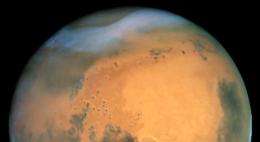Many characteristics of Mars, including ice, are similar to Earth

Mars gets as far as 250 million miles away, but many parts of it closely resemble places on Earth, including its landscape, history of water, soil and even its weather, says a Texas A&M University researcher in the current issue of "Science" magazine.
Mark Lemmon, a professor of atmospheric sciences who has been involved with Mars missions for years, says last year's Phoenix Mars Lander mission keeps revealing secrets about the planet, answering some questions but raising other big ones. He is one of several authors detailing the Phoenix discoveries.
"Phoenix landed in a place that has access to Martian ice, which is exciting by itself," Lemmon says of the Mars probe, which landed May 25, 2008. The mission goals were to investigate the suitability of Mars for past or present life, but Phoenix was incapable of detecting life itself.
"Phoenix was designed to verify and investigate subsurface ice, and it found it almost instantly," he explains. The entire area where it landed has water ice just a few inches under the soil. The area is cold now, but it has been warmer in the past."
NASA's charge to researchers on the mission has been simple: "Follow the water," meaning examine all aspects of water - or ice - on Mars. No water in a liquid state has been found yet, Lemmon says, but there is new evidence that Mars had liquid water billions of years ago.
Using its robotic arm, the Mars Lander was able to scoop up dirt, which was mixed with ice, and analyze it, Lemmon says.
"Where it landed is a barren place that resembles the dry valleys of Antarctica," he adds. "The area has mounds and troughs, and just like in Antarctic valleys, there is no liquid water but plenty of ice.
"Some of these patches are fairly pure. Others have the ice mixed with soil containing energy sources and nutrients that could be used if there were life."
Lemmon says the soil has perchlorate, a form of chlorine that is considered hazardous, but certain types of bacteria are able to live on it here.
"The interesting thing is, the soil has a potential energy source and oxygen source for life on Mars," he notes.
Traces of calcite were also found, which shows a presence of liquid water at some time in the past, Lemmon notes.
Phoenix also found weather patterns similar to those on Earth, including cold fronts that bring in gusty winds and sub-freezing temperatures.
Another bonus: Phoenix saw small Martian snowflakes, which leads the team to believe that snowfall on Mars was once a common occurrence.
"To sum it up, we found a place on Mars that is similar to cold, dry environments on Earth, and those environments are capable of supporting life," Lemmon explains.
"There are numerous signs of a history of water on Mars. The snowflakes indicate to us that there are weather patterns on Mars similar to those on Earth. Phoenix has given us valuable insights into Martian weather and soil, and it gives us clues as to how we should proceed with future investigations of Mars."
Source: Texas A&M University





















